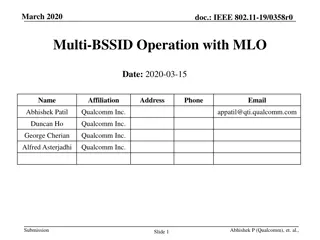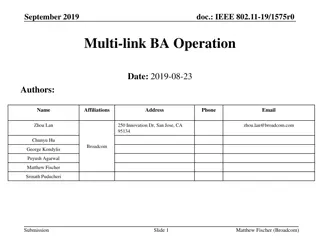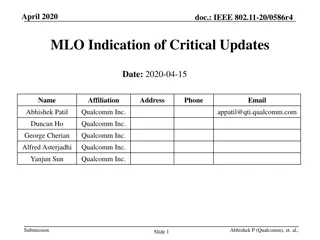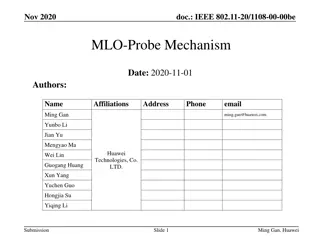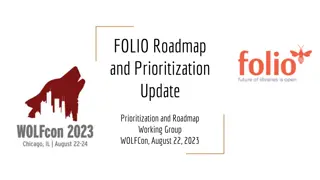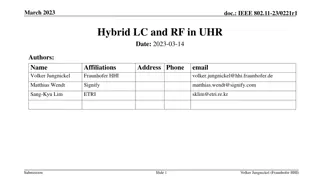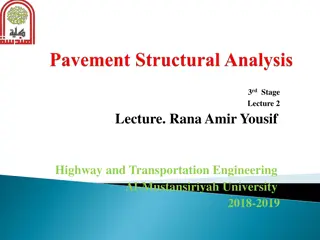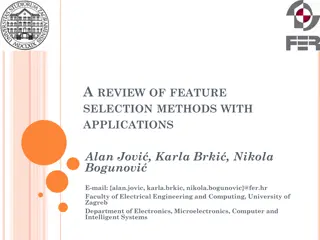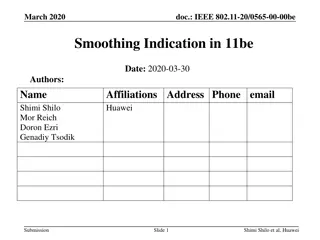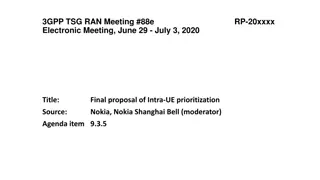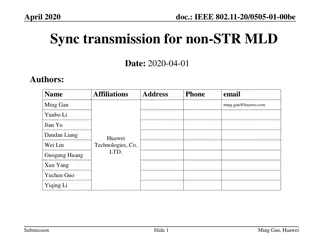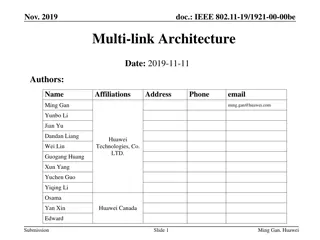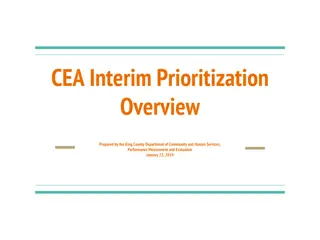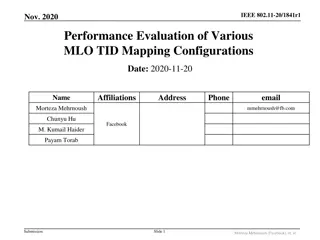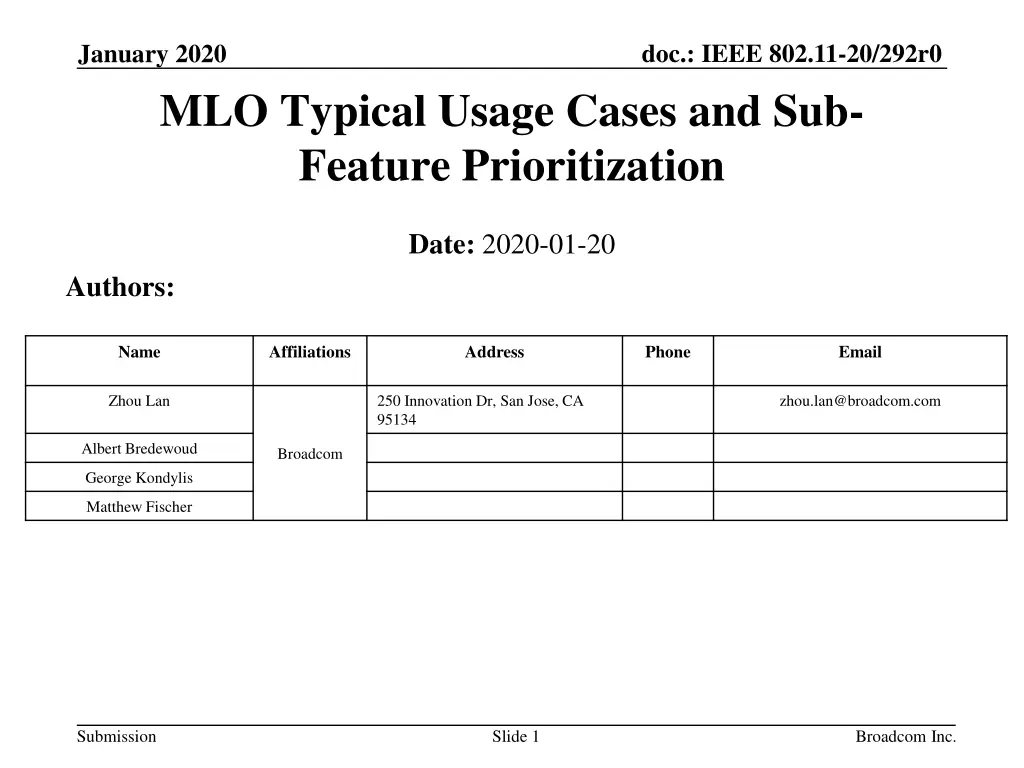
IEEE 802.11-20/292r0 January 2020 MLO Operation Scenarios & Features
"Explore MLO operation scenarios & sub-feature prioritization in IEEE 802.11-20/292r0 January 2020 document. Discusses typical usage cases, bandwidth support, system throughput, link aggregation, and MLO modes for increased performance."
Download Presentation

Please find below an Image/Link to download the presentation.
The content on the website is provided AS IS for your information and personal use only. It may not be sold, licensed, or shared on other websites without obtaining consent from the author. If you encounter any issues during the download, it is possible that the publisher has removed the file from their server.
You are allowed to download the files provided on this website for personal or commercial use, subject to the condition that they are used lawfully. All files are the property of their respective owners.
The content on the website is provided AS IS for your information and personal use only. It may not be sold, licensed, or shared on other websites without obtaining consent from the author.
E N D
Presentation Transcript
doc.: IEEE 802.11-20/292r0 January 2020 MLO Typical Usage Cases and Sub- Feature Prioritization Date: 2020-01-20 Authors: Name Affiliations Address Phone Email Zhou Lan 250 Innovation Dr, San Jose, CA 95134 zhou.lan@broadcom.com Albert Bredewoud Broadcom George Kondylis Matthew Fischer Submission Slide 1 Broadcom Inc.
doc.: IEEE 802.11-20/292r0 January 2020 Summary This contribution discusses the MLO typical operation scenarios and proposes MLO sub-feature prioritization Submission Slide 2 Broadcom Inc.
doc.: IEEE 802.11-20/292r0 January 2020 Today Today, AP with 4x4 antenna, STA with 2x2 antenna become mainstream devices on the market Most of APs support bandwidth 160 MHz, a few STAs support bandwidth 160 MHz Dual/Tri-band APs are available E.g. 2.4GHz+5GHz(low)+5GHz(high) Each band establishes its own BSS and operates independently i.e. each band supports aysnc. mode without coordination (no sync. mode) Two 5 GHz radios can be configured to operate on the same channel sharing the same bandwidth Peak system throughput (SU or MU) on one 5GHz reaches 2.4Gbps (160MHz, 2SS, 1024QAM) Throughput can not be aggregated across BSSs (i.e. across links) Some proprietary implementation may support link aggregation, but there is no standard specified to guarantee the interoperability BSS on link 1 BSS on link 2 AP1 (4x4) AP2 (4x4) Link 2 (160 MHz) Link 1 (160 MHz) SU/MU PPDU SU/MU PPDU STA 1 (2x2) STA2 (2x2) Submission Slide 3 Broadcom Inc.
doc.: IEEE 802.11-20/292r0 January 2020 One baby step towards real MLO 802.11be decides to supports 240/320 MHz bandwidth and 4K QAM Per the current timeline (D1.0 ready @May 2021), it is realistic to assume STA may only support 2 or less antennas Peak throughput on each link: 4.3 Gbps@5GHz (2SS, 240 MHz, 4K QAM) and 5.7 Gbps@6GHz (2SS, 320 MHz, 4K QAM) By defining a mechanism to support multiple links operating in a single BSS boosts the system throughput to 10 Gbps (4.3+5.7) Call this mode of MLO operation as flow level aggregation in this presentation No intention to propose such terminology in 11BE spec 10 Gbps throughput is shared by multiple applications (i.e. multiple ACs, multiple TIDs), which should be sufficient to cover all the current and near future usage cases (e.g. AR/VR, HD Video Streaming) Example operation MLO association Each TID maps to a single link BA agreement on MLD level No simultaneous outstanding MPDUs (i.e. MPDUs that are not ACKed) on multiple links Single BSS on both links AP MLD TID 1 TID 2 AP1 (4x4) AP2 (4x4) Link 2 (320 MHz) Link 1 (240 MHz) TID 2 TID 1 SU PPDU SU PPDU STA 1 (2x2) STA2 (2x2) STA MLD Submission Slide 4 Broadcom Inc.
doc.: IEEE 802.11-20/292r0 January 2020 Single TID split across links 802.11be decides to support a MLO mode that can split single TID QoS data to multiple available links There can be outstanding MPDUs on multiple available links at the same time Call this mode of MLO operation as packet level aggregation in this presentation Packet level aggregation offers single TID throughput gain but no further system throughput gain Packet level aggregation may offer latency gain depending on implementation architecture It is hard to justify high MAC split can provide latency gain due to long delay of re-queue operation of the retransmits Low MAC split is not easy to implement per the current timeline Low MAC split requires significant amount of information exchanges across links Low MAC split requires actuate time sync across links Etc. Single BSS on both links AP MLD TID 1 AP1 (4x4) AP2 (4x4) Link 2 (320 MHz) Link 1 (240 MHz) TID 1 TID 1 SU PPDU SU PPDU STA 1 (2x2) STA2 (2x2) STA MLD Submission Slide 5 Broadcom Inc.
doc.: IEEE 802.11-20/292r0 January 2020 Straw poll 1 Do you agree the reception of QoS Data frames of a single TID across multiple available links is optional for R1 The transmitting STA splits QoS Data frames of a single TID to multiple available links for AMPDU aggregation, the outstanding MPDUs (i.e. the MPDUs not ACKed) may be transmitted on multiple links at the same time) The receiving STA indicates if it is capable of receiving such AMPDUs from multiple available links Note- A link is available when the link is enabled and the associated STA is in awake state Yes No Abs *The results of straw poll 1 decides straw poll 2. If the group decides to push packet level aggregation to R2, then MU operation on MLO is same as MU operation on single link. Submission Slide 6 Broadcom inc.
doc.: IEEE 802.11-20/292r0 January 2020 Pursuing peak system throughput The main role of MLO should be boosting system throughput to reach the maximum PHY capability, which is difficult to be achieved with SU operation DL MU MIMO + MLO boosts the system throughput to 20 Gbps 8.6 Gbps @ 5GHz (4SS, 240 MHz, 4K QAM) 11.4 Gbps @ 6GHz (4SS, 320 MHz, 4K QAM) Packet level aggregation is complimentary to the MU operation for latency improvement, however has implementation implication of complicated queue management etc. Single BSS on both links AP MLD AP1 (4x4) AP2 (4x4) Link 2 (320 MHz) Link 1 (240 MHz) MU PPDU (DL MU MIMO) MU PPDU (DL MU MIMO) STA 1 (2x2) STA2 (2x2) STA 1 (2x2) STA MLD 4 STA2 (2x2) STA 1 (2x2) STA MLD 3 STA2 (2x2) STA 1 (2x2) STA MLD 2 STA2 (2x2) STA MLD 1 Submission Slide 7 Broadcom Inc.
doc.: IEEE 802.11-20/292r0 January 2020 Flexibility DL OFDMA + MLO doesn t provide further throughput enhancement Peak throughput on each link: 4.3 Gbps@5GHz (2SS, 240 MHz, 4K QAM) and 5.7 Gbps@6GHz (2SS, 320 MHz, 4K QAM) Mixed PPDU + MLO however provides flexibility of operation STA 1 requires more than 240 MHz capacity but less than 240+320 MHz AP MLD may MLO 240 MHz@link1 + 80 MHz (996 RU) to STA MLD 1 AP2 may utilize the left of bandwidth to transmit legacy OFDMA 160 MHz (2x996 RU) to STA3 Packet level aggregation is complimentary to the MU operation for latency improvement, however has implementation implication of complicated queue management etc. Single BSS on both links AP MLD AP1 (4x4) AP2 (4x4) Link 2 (320 MHz) Link 1 (240 MHz) MU PPDU (DL OFDMA) SU PPDU STA 1 (2x2) STA 3 (2x2) STA2 (2x2) STA MLD 1 Submission Slide 8 Broadcom Inc.
doc.: IEEE 802.11-20/292r0 January 2020 Straw poll 3 When transmitting STA splits QoS Data of single TID to multiple available links, what is the maximum number of links do you support for 11be R1? 2 3 Others Submission Slide 9 Broadcom inc.
doc.: IEEE 802.11-20/292r0 January 2020 Async. and Sync. operation Terminologies Non-Constrained MLO mode: A STA/AP MLD is under the Non-Constrained MLO mode if the MLD operation links support concurrent TX/RX operations across the links Constrained MLO mode: A STA/AP MLD is under the Non-Constrained MLO mode if the MLD operation links DON T support concurrent TX/RX operations across the links Four practical MLO scenarios: Async. TX, Async RX scenario: An AP MLD under Non-Constrained mode transmits data and solicits response from a STA MLD under Non-Constrained mode Async. TX, Sync RX scenario: An AP MLD under Non-Constrained mode transmits data and solicits response from a STA MLD under Constrained mode Sync. TX, Async RX scenario: A STA MLD under Constrained mode transmits data and solicits response from an AP MLD under Non-Constrained mode Sync. TX, Sync RX scenario: A STA MLD under Constrained mode transmits data and solicits response from an AP MLD under Constrained mode Aysnc. operation Sync. operation Submission Slide 10 Broadcom Inc.
doc.: IEEE 802.11-20/292r0 January 2020 Straw poll 4 Do you agree the following 3 mode of MLO operation are in 11be R1 sub- features? Async. TX, Async RX scenario: An AP MLD under Non-Constrained mode transmits data and solicits response from a STA MLD under Non-Constrained mode Async. TX, Sync RX scenario: An AP MLD under Non-Constrained mode transmits data and solicits response from a STA MLD under Constrained mode Sync. TX, Async RX scenario: A STA MLD under Constrained mode transmits data and solicits response from an AP MLD under Non-Constrained mode Note-Terminology may be unified with other contributions Yes No Abstain Submission Slide 11 Broadcom inc.
doc.: IEEE 802.11-20/292r0 January 2020 Cross link power save SU PPDU MU PPDU There are already many sub features of MLO Cross link signaling for power save is a nice to have optimization and should be positioned as R2 mixed PPDU PPDU Types Async. Priority Sync. Channel access Packet level aggregation Data transmission and acknowledgement Cross link signaling for power save (TIM, PM, TWT etc.) Complexity Submission Slide 12 Broadcom Inc.
doc.: IEEE 802.11-20/292r0 January 2020 Straw poll 5 Do you agree all the cross link power save sub features (TIM, PM, TWT, etc.) of MLO are in 11be R2 Yes No Abs Submission Slide 13 Broadcom inc.


